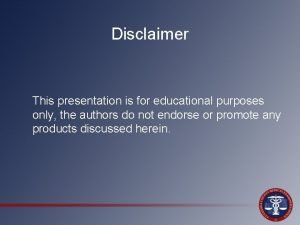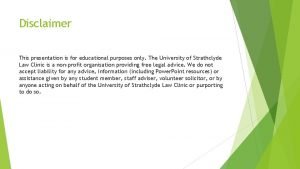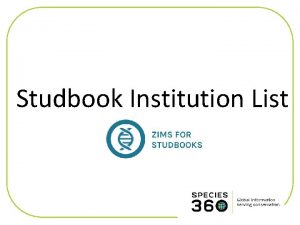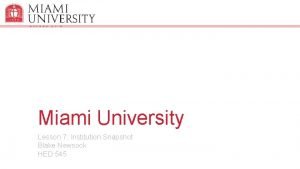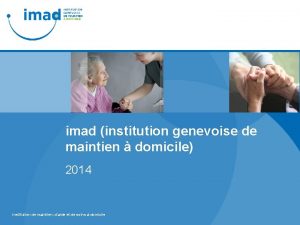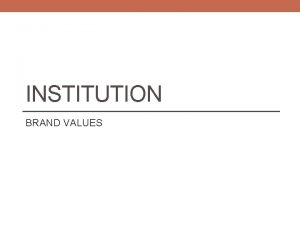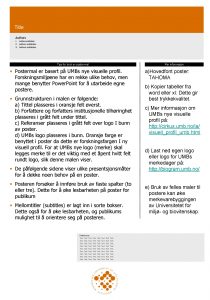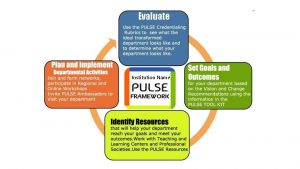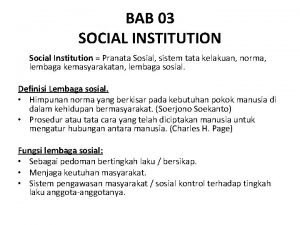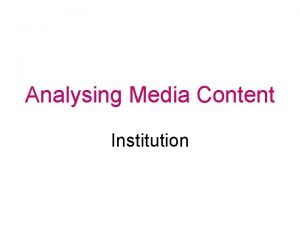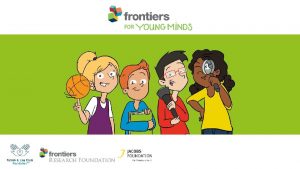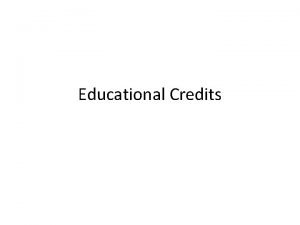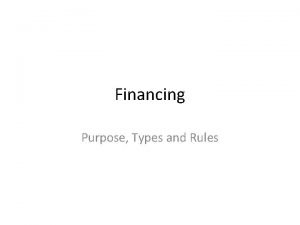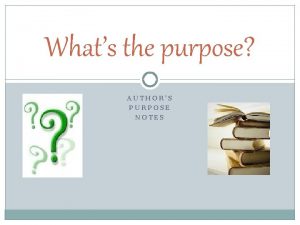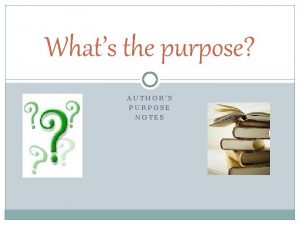The purpose of an educational institution is to































- Slides: 31

“The purpose of an educational institution is to lead the students, who initially believe the educational institution is there to educate them, to the realization that they must educate themselves. ” “They must …learn how to learn [integratively]…” From Willis Hurst, MD, Medscape [and Pelley]

Writing Course and Clerkship Objectives John W. Pelley, Ph. D www. ttuhsc. edu/SOM/success

“Mind Bender” • Talk to a neighbor to answer, • “Is a test question an expectation or an outcome? ” • And, “Are testing and evaluation the same thing? ”

The Learning Cycle Some Motor Skills Thinking Skills Sensory Skills Memory Skills Zull, 2002, The Art of Changing the Brain 4

Expectations vs. Outcomes • Objectives state learning expectations – How well have the students used their brains? • • Testing measures learning outcomes Evaluation compares expectations vs. outcomes Applies to teacher and students Therefore, – Testing is what happened – Evaluation is what it means – Objectives help evaluation

Test Questions Are Outcomes – After The Test • Reliable and valid measure of: Øteaching effectiveness Ølearning effectiveness • memory skills • thinking skills • Ambiguity in objectives affects reliability and validity.

Test Questions Are Expectations – Before The Test • Test questions are also learning objectives. • Learning objectives are most easily written as short essay test questions. – Long essay questions are too vague. • Effective objectives help in writing effective test questions!

Objectives For Different Kinds Of Learning • State what you want the student to be able to do in an essay question format. Ask for – Written skills (e. g. typical study notes), – Oral skills (e. g. interviewing), – or Psychomotor skills (e. g. physical examination).

Example of Ambiguous Learning Objective • “Faculty will be able to modify course goals and objectives based on the principles taught at this session. ” – But, why would I need to modify my objectives? – Also, what kind of objectives am I writing – teaching objectives or learning objectives? – And, will the modifications be an improvement? For who? • Conclusion: This objective doesn’t mean the same thing to everybody.

Better Learning Objective For a given topic, participants will be able to… • determine the appropriate content to be learned. • determine the appropriate level of complexity to be learned. • compose a written objective that specifies a mental or physical behavior.

Restated As Essay Questions – “Learning Objectives” For a given topic… • describe the appropriate content to be learned. • describe the appropriate level of complexity to be learned. • compose a written objective that specifies a mental or physical behavior.

GRIPE Objectives – Sample Compare: coagulative necrosis; liquefactive necrosis; gangrenous necrosis; caseous necrosis; fat necrosis; fibrinoid necrosis; and apoptosis in terms of: 1. common sites or tissues involved and reasons for this 2. common causes or causative mechanisms 3. gross and microscopic appearance 4. types and extent of healing (GRIPE = Group for Research in Pathology Education) 12

Learning Objectives Produce Teaching Objectives • If you think about the outcome (learning objectives), the teaching process will automatically follow. • Learning objectives help us – teach “thinking. ” – write better test questions.

Levels Of Learning (Complexity) Memorization skills • Recall (linear thinking) – “Just the facts ma’am” HOTS (Higher Order Thinking Skills) • Analysis (grouping, indexing) – How are facts grouped into patterns? • Comparison (patterns) – How are patterns related? • Inference (concluding) – What is deduced? [diagnosis] • Evaluation (future vision) – What is predicted? [clinical treatment and management]

Learning Objective Examples • Recall – Define hyperglycemia, ketoacidosis, glycosylation • Analysis – Give the characteristics of type 1 diabetes. • Comparison – Explain how type 1 and type 2 diabetes are both similar and different. • Inference – Explain your diagnosis of type 2 diabetes. • Evaluation – Justify a treatment plan for a type 2 diabetic.

Pre-frontal Pause • Which level is most important? – Recall – Analysis – Comparison – Inference – Evaluation • Talk with a neighbor for 1 minute to decide.

Recall Level Objectives • • List the ____. Describe ____. Define the term ____. Name ____.

HOTS Objectives • Explain how the conclusions are supported by the data/facts/evidence. • Compare (symptoms) before and after (procedure). • Classify ____ according to ____. • Distinguish ____ from ____. • Explain how ____ works. • Predict what will happen if (treatment).

Easier Objective Writing From NBME Question Templates • Use the NBME question templates in the handout materials “Creating Effective Learning Objectives and Test Questions. ” – www. nbme. org – Item writers guide contains question templates

Sample NBME Question Template • Insert patient vignette describing a patient with a problem. Which of the following is the vessel into which contrast medium should be injected during fluoroscopy to visualize the site of the abnormality? • Question form: – “Which of the following is the vessel into which …” • Objective form: – “Explain where and why…”

A word of caution • If an objective requires a response that has been explicitly taught, it is actually testing only rote memory (recall). • A HOTS objective must require the student to generalize or apply what he or she knows to a new situation.

Recall Sample Questions • • • List the ____. Define the term ____. What is a ____? Who did ____? Name ____. – Note: Any question becomes a recall question if the answer has already been explicitly provided to the student in class or in the text.

Recall Trigger Words • • define list name identify who what when

Analysis Sample Questions • • • Classify ____ according to ____. Explain how ____ works. What kind of a ____ is this? What is the function of ____ ? What is the relationship between ____ and ____ ? (classification/grouping relationships)

Analysis Trigger Words • • • break down relationship how it works how it's used give an example

Comparison Sample Questions • • • How is ____ like ____ ? How are ____ and ____ different? Compare the _____ before and after ______. Distinguish between _______ and ____. Compare ____ with ____. Which one is the best/worst?

Comparison Trigger Words • • • compare contrast distinguish alike different

Inference Sample Questions • • • Hypothesize what will happen if ____. Predict what will happen if ____. Solve the problem ____. What if ____ ? What rule applies here? What generalization can you make from this information?

Inference Trigger Words • • hypothesize synthesize use (provide evidence found…) apply (state a rule…) generalize what if conclude solve

Evaluation Sample Questions Why was the argument convincing? Did ____ behave/respond appropriately? What would you have done in this situation? Why? Was this experiment well designed? Defend your answer. • Judge which is the best solution to the problem. Why do you think so? • How well are the conclusions supported by the data/ facts/evidence? Explain. • Which ____ is the best? Why do you think so? • •

Evaluation Trigger Words • • judge evaluate best solution justify defend critique defend
 Formal institution and informal institution
Formal institution and informal institution Federal state autonomous educational institution
Federal state autonomous educational institution This account is for educational purposes only
This account is for educational purposes only Disclaimer for presentation
Disclaimer for presentation Educational purpose only#
Educational purpose only# Tư thế ngồi viết
Tư thế ngồi viết Thứ tự các dấu thăng giáng ở hóa biểu
Thứ tự các dấu thăng giáng ở hóa biểu Voi kéo gỗ như thế nào
Voi kéo gỗ như thế nào Thẻ vin
Thẻ vin Thể thơ truyền thống
Thể thơ truyền thống Từ ngữ thể hiện lòng nhân hậu
Từ ngữ thể hiện lòng nhân hậu Sự nuôi và dạy con của hổ
Sự nuôi và dạy con của hổ Diễn thế sinh thái là
Diễn thế sinh thái là Thế nào là hệ số cao nhất
Thế nào là hệ số cao nhất Vẽ hình chiếu vuông góc của vật thể sau
Vẽ hình chiếu vuông góc của vật thể sau Ng-html
Ng-html Làm thế nào để 102-1=99
Làm thế nào để 102-1=99 Lời thề hippocrates
Lời thề hippocrates Vẽ hình chiếu đứng bằng cạnh của vật thể
Vẽ hình chiếu đứng bằng cạnh của vật thể Tư thế worm breton
Tư thế worm breton đại từ thay thế
đại từ thay thế Quá trình desamine hóa có thể tạo ra
Quá trình desamine hóa có thể tạo ra Công thức tiính động năng
Công thức tiính động năng Khi nào hổ con có thể sống độc lập
Khi nào hổ con có thể sống độc lập Thế nào là mạng điện lắp đặt kiểu nổi
Thế nào là mạng điện lắp đặt kiểu nổi Các châu lục và đại dương trên thế giới
Các châu lục và đại dương trên thế giới Dot
Dot Bổ thể
Bổ thể Biện pháp chống mỏi cơ
Biện pháp chống mỏi cơ Phản ứng thế ankan
Phản ứng thế ankan Thiếu nhi thế giới liên hoan
Thiếu nhi thế giới liên hoan Hát lên người ơi alleluia
Hát lên người ơi alleluia


